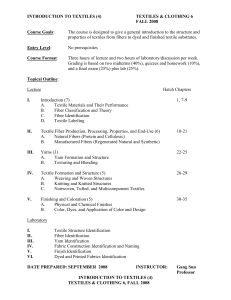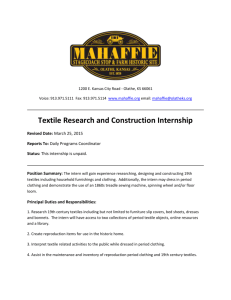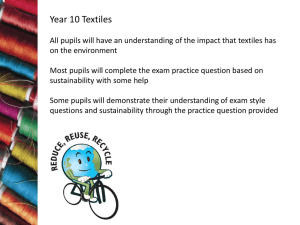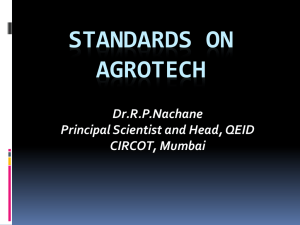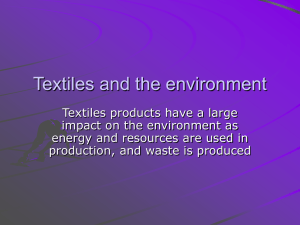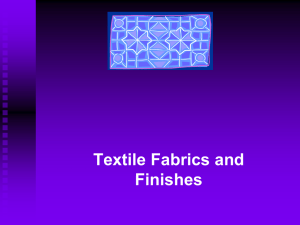textiles and clothing design
advertisement
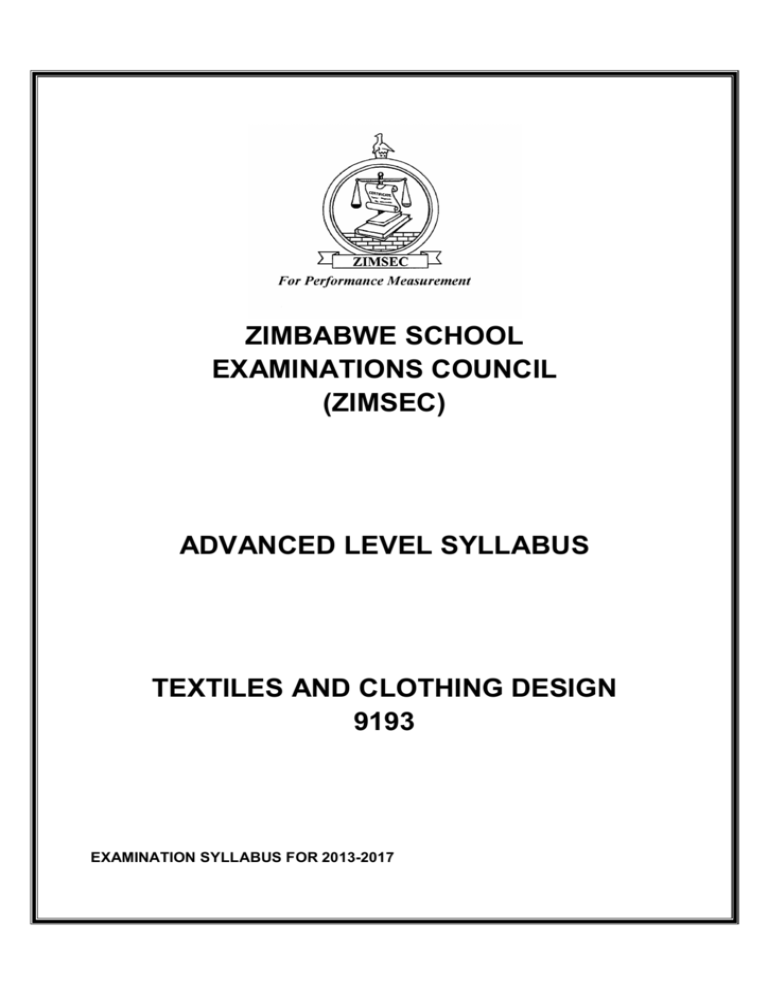
ZIMBABWE SCHOOL EXAMINATIONS COUNCIL (ZIMSEC) ADVANCED LEVEL SYLLABUS TEXTILES AND CLOTHING DESIGN 9193 EXAMINATION SYLLABUS FOR 2013-2017 TEXTILES AND CLOTHING DESIGN ADVANCED LEVEL SUBJECT CODE: 9193 This syllabus is available in November only in Zimbabwe and other approved centres. 1.0 PREAMBLE This subject covers the study of textiles and clothing design over a period of two years. It is intended for the O-Level graduate, who would like to pursue further studies in Textiles and Clothing technology, management, research and development, merchandising and designing. Practical work is an integral and expected part of the course. The syllabus requires scientific and investigative work. Teachers are, therefore, advised to ensure that candidates undertake experimental work in an appropriate and safe environment, preferably a Chemistry/Science laboratory. To gain entry, the student must have obtained at least Grade B in O-Level Fashion and Fabrics and any two of the following: Chemistry, Physics, Mathematics, Biology and Physical Science. Industrial attachment is highly recommended for a minimum period of five days. 2.0 AIMS The aims are to: 2.1 develop scientific, technical, creative and problem solving skills in the study of textiles and clothing 2.2 develop the ability to express and communicate ideas through appropriate terminology and media 2.3 expose students to the functional, cultural, historical, aesthetic, economic and managerial aspects of textiles and clothing 2.4 provide opportunity for further study in textiles and clothing. 2 3.0 ASSESSMENT OBJECTIVES By the end of the two year course, students should be able to:- 3.1 analyse the relationship between textile properties and human needs 3.2 demonstrate scientific knowledge of the composition, structure and processing of textile fibres, yarns and fabrics 3.3 select and apply relevant theoretical and technical knowledge of textiles and clothing in solving problems 3.4 demonstrate research skills 3.5 apply investigative skills in evaluating production processes and the inherent nature of textiles 3.6 evaluate, select and apply appropriate cultural designs and production processes to textile products 3.7 design styles, draft and adapt patterns for various occasions and figure types 3.8 analyse fundamentals associated with the subject and communicate the ability to use them in the students’ areas of interest 3.9 assess effects of socio-economic, political, environmental, cultural and technological factors affecting the textile and clothing industry 4.0 TIME ALLOCATION To achieve the stated objectives for this syllabus, it is important to allocate 8 – 12 periods per week. 5.0 METHODOLOGY To help students attain the stipulated objectives, it will be important for the teacher to use problem solving and experimental approaches. The teacher’s role is mainly to facilitate the learning process and allow the students to explore and discover for themselves. The following methods can be used: 3 Field trips to cotton farms, cotton ginneries, cottage industries, universities research centres, textile and clothing industries. Attachments: students can be attached to textile and clothing industries, cottage industries and research centres. Experimental work. Class discussions, group activities and presentations. Practical assignments. Demonstrations. Short lectures. 6.0 ASSESSMENT SCHEME 6.1 Paper 1: Theory (3 hours) 50% This paper is divided into two sections, A and B. Section A - 40 marks This section comprises compulsory short answer type questions. Section B - 60 marks This section comprises five questions from which candidates should answer three. Each question carries 20 marks. 6.2 Paper 2: Coursework 20% Coursework is to be marked by the teacher and moderated by an external examiner. It should comprise the following: 6.2.1 Written Tests (at least 10) 20% 6.2.2 Assignment (at least 8) 20% 4 6.2.3 Practicals/Experiments 20% 6.2.4 Project (to be presented to class) 40% 6.3 30% Paper 3: Independent Study This is marked by an external examiner. 7.0 ASSESSMENT SPECIFICATION GRID OBJECTIVE PAPER 1 NUMBER THEORY 1 + 2 + 3 + 4 + 5 6 + 7 + 8 9 + 8.0 SYLLABUS CONTENT 8.1 TEXTILE TECHNOLOGY PAPER 2 COURSEWORK + + PAPER 3 INDEPENDENT STUDY + + + + + + + + + + + + 8.1.1 Fibres: Physical and chemical properties The molecular structure Effects of solar radiation Fibre, identification of Natural: Regenerated: Synthetic: Cellulosic – cotton, flax Protein – wool, mohair, silk Mineral – asbestos, metallic Viscose/rayon, modified rayons, acetates. polyamide, polyester, acrylic Processing of natural fibres Cotton, linen, wool and silk Synthetic fibre production Wet, dry and melt spinning Continuous filament production Staple fibre production 5 8.1.2 Yarns: Yarn production Spinning processes – ring/mule – open end Simple yarns, fancy yarns Texturising yarns Yarn properties Amount and direction of twist (s and z) Fitness, smoothness, lustre, handle, cohesiveness Systems of yarn count Tex, denier (metric system) 8.1.3 Fabrics Fabric construction Weaving Weaving equipment Weaving processes: - Warp preparation – warping, sizing, mounting Weft preparation – winding of quills Shedding mechanisms – tappet/cam, dobby, jacquard Weft insertion methods – shuttle, shuttles (jet, rapier, gripper) Structures of weaves Samples of weaves Knitting Knitting techniques Weft knitting – weft knitting machines – weft fabric construction Warp knitting – warp knitting machines (raschel, tricot, double tricot, atlas, double atlas) Structure of knitted fabrics Samples of knitted fabrics 6 Other methods of fabric construction Narrow fabrics – lace, braid Non-woven fabrics – felt, needle punched, bonded fibre, stitch bonded, laminated, coated and tufted fabrics. Blended fabrics and mixtures Reasons for their production A collection of samples of these fabrics Fabric properties Strength, extensibility, abrasion characteristics, air permeability 8.1.4 Finishing textiles Finishes Finishing processes which affect the appearance, handle, dimensional stability and serviceability of yarns and fabrics as produced by the following treatments: warp sizing, scouring, milling, tentering, rising, cropping and pressing. bleaching, mercerization, drying, delustruring, optical bleaching, crepe finishing, calendaring, moiré, embossing, beetling. waterproofing, stain and water-repellency, crease resistance, minimum care fabrics and permanent press effects. flame retardance, moth proofing, antistatic finishes. Colour: Types of dyes direct, disperse, mordant, reactive, pigment, natural dyes, dyeing of fibres, yarns and fabrics. Printing techniques block, stencil screen, roller, direct, resist, discharge, transfer, flock. Colour fastness effects of laundering, dry cleaning, bleaching, rubbing and perspiration. 7 8.2 8.3 CLOTHING DESIGN Elements of design line, form, shape, colour, texture Principles of design rhythm, balance, emphasis, harmony, proportion and scale. Styles for different occasions, figure types, seasons and age groups. Factors affecting design culture, history, social and economic development, colour, mass media, fashion changes. Tools and equipment for designing silhouettes, motion drawings, pose, mood, style features, use of colour and media. Pattern drafting sizing systems principles of pattern construction anthropometry/body symmetry block, working, final and master patterns, Computer Aided Design and Computer Aided Manufacture (CADCAM) Pattern adaptation to size and style Fabric, trimmings, notions estimating amounts suitability, rating, choice and application Costing calculating costs for fabrics, trimmings, notions, labour and overheads. GARMENT CONSTRUCTION Manufacturing processes cutting and sewing techniques, finishing and quality checking. Sewing machines domestic Industrial (various types) Pressing equipment steam presser vacuum presser 8 8.4 BUSINESS STUDIES Marketing The nature and role of marketing with an organisation. Marketing research Product development Consumer services Planning and Control of Business decisions Planning, organisation and control with reference to the production of textiles and clothing. Use of computers (CADCAM) Cost accounting budgets and profit forecasts. Production Production functions Methods of scale production Impact of change and innovation upon production methods Quality control. Entrepreneurship/Small Scale Business Objectives for starting a business Types of businesses Factors that affect business activities Business finance: sourcing funds business proposals book-keeping Business communication and sales skills (advertising) 9.0 NOTES 9.1 COURSEWORK 9.1.1 Suggestions for Practicals/Assignments – Fibre identification burning tests chemical tests microscopic examination – Fabrics construction samples – Yarn production and collection of samples 9 – Fabric dyeing Tie and dye Batik Screen printing Block printing – Clothing design and construction – Fashion sketching/illustration – Pattern drafting and adaptation – Written tests 9.1.2 Project Develop a design and print on the woven cotton fabric, construct an article, cost and market it. To be presented to class (write up 30%, presentation 10%). NB: Each student should purchase five metres of woven cotton fabric, prepared for printing/dyeing (PFP/D). (Such fabric has gone through the scouring and bleaching processes but not yet dyed or printed). This would be used for the project, practical experiments or samples. The coursework and marks should be submitted to ZIMSEC by 31st October of the final year. 9.2 INDEPENDENT STUDY Guidelines This assignment should show the student’s interest in a specific aspect of textiles and clothing. The study can investigate a commercial, scientific, technical, historical, artistic, aesthetic aspect or incorporate a combination of any of these. Independent studies will be presented to the Zimbabwe School Examinations Council (ZIMSEC) for assessment, in a suitable folder, supported by practical work where appropriate. Choice of the area of study should be done by 30th September of the first year of the course. The completed study should be submitted to ZIMSEC by 31st October of the final year. 10 The study should be 4000 – 5000 words in length. This excludes the following:– – – – diary of events interviews and questionnaires annotations alongside graphs, photographs, pie charts, samples labelled diagrams and flow charts These can be included in appendices after the bibliography. The report should be simply but attractively presented and clearly labelled with: – – – – candidate’s full name and number centre name and number subject code and paper number title of the study Mark allocation for study 1. Concise topic which is manageable (2) 2. Important/significance of area of investigation (6) 3. Clear statement(s) of aim(s) (4) and objectives (6) (10) 4. Overall plan of action (10) 5. Literature review/Related literature (10) 6. Methodology (15) 7. Presentation of findings (10) 8. Evaluation/analysis (12) 9. Lesson(s) leant (5) 10. Conclusion (5) and recommendation(5) (10) 11. Bibliography (5) 12. Overall presentation (neatness, layout, language) (5) Total [100] 11 10.0 REFERENCE BOOKS Bray, N. (1995). Dress Pattern Designing: The Basic Principles of Cut and Fit. Clamp, L & Bohdangwicz, J. (1994). Fashion Marketing, Routledge. Collier, A.M. (1974). A Handbook of Textiles, Oxford: Pergamon Press. Cooper, H. & Vulker, J. (1987). Textiles, Fabric and Design, Heinemann. Daniels, P.N., Tubs, M.C. (1991). Textile Terms and Definitions, U.K. Textile Institute. Giles, R. (1976). Fabrics for Needlework, London, Toronto, Sydney, Wellington: Methuen Educational. Gohl, E.P.G. & Vilensky, L.D. (1983). Textile Science, Cheshire, Longman. Gohl, E.P.G. & Vilensky, L.D. (1974). Textile for Modern Living, Cheshire, Longman. Grieser, Lyle et al. (1973). Guide to Modern Clothing, McGraw Hill. Hartley & Row. (1982). Topics and Questions in Textiles, Heinemann. Hollen & Sadler (1979). Textiles, Macmillan. Kadolph, S. et. al. (1991). Textiles, New York. Readers Digest (1987). A Complete Guide to Sewing, London, Cape Town: Digest Association Ltd. Shoben, M. & Ward, J. (1985). Pattern Cutting and Making up. The Professional Approach. London: Batsford Educational. Smith, B. F. & Block, I. (1982). Textiles in Perspective. Englewood Cliffs: Prentice. Storey, J. (1992). Manual of Textile Printing, U.K.: Thames and Hudson. Tayloer, M.A. (1972). Technology of Textile Properties, London Forbes Thomson, H. (1967). Working with Textile Properties, London: Heinemann 12 Additional copies of the syllabus and specimen question paper booklets can be ordered from ZIMSEC. All correspondence should be addressed to: ZIMBABWE SCHOOL EXAMINATIONS COUNCIL P O BOX CY 1464 CAUSEWAY HARARE TELEPHONE: FAX: 304551-3 302288; 339080 13

